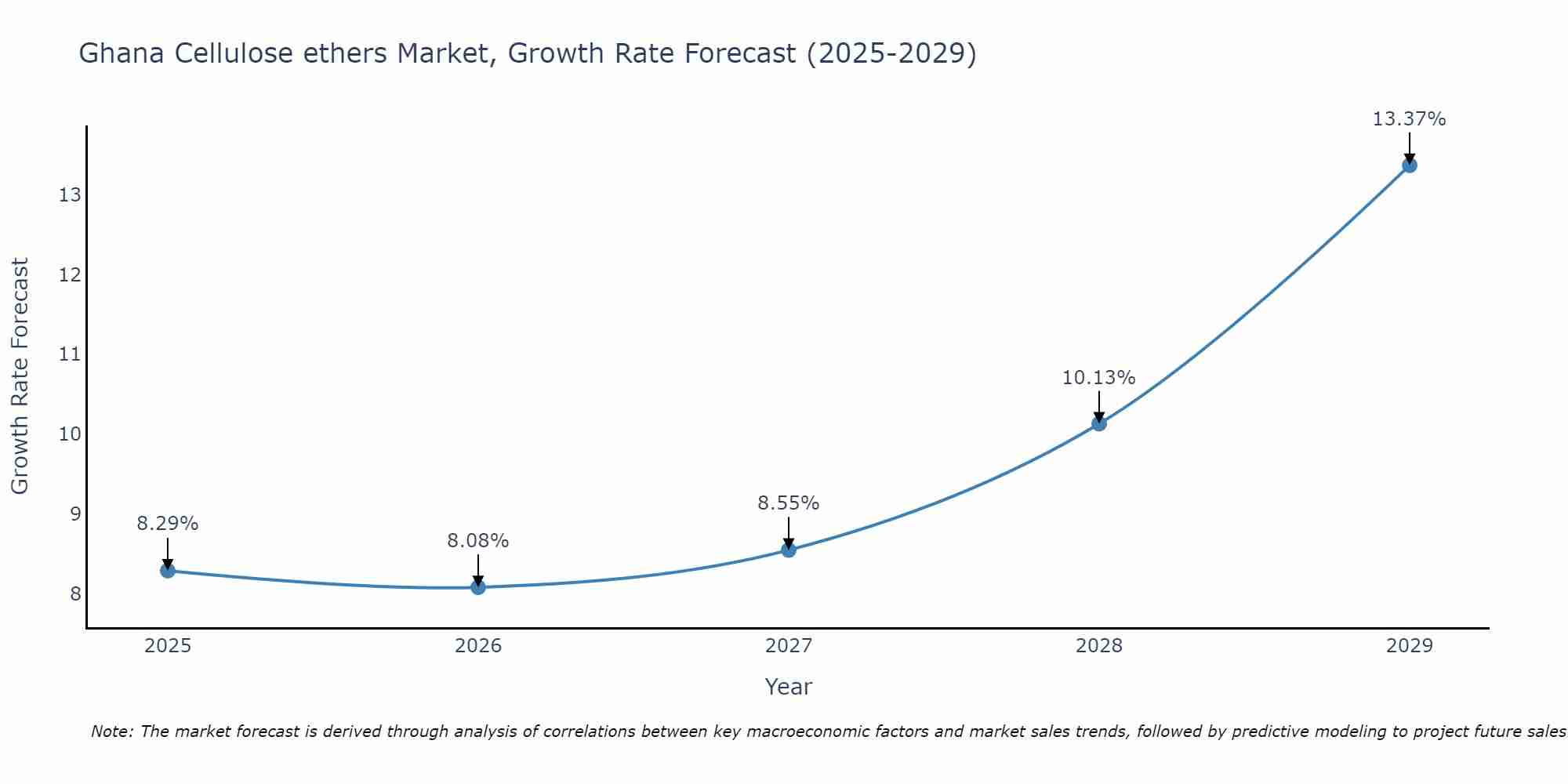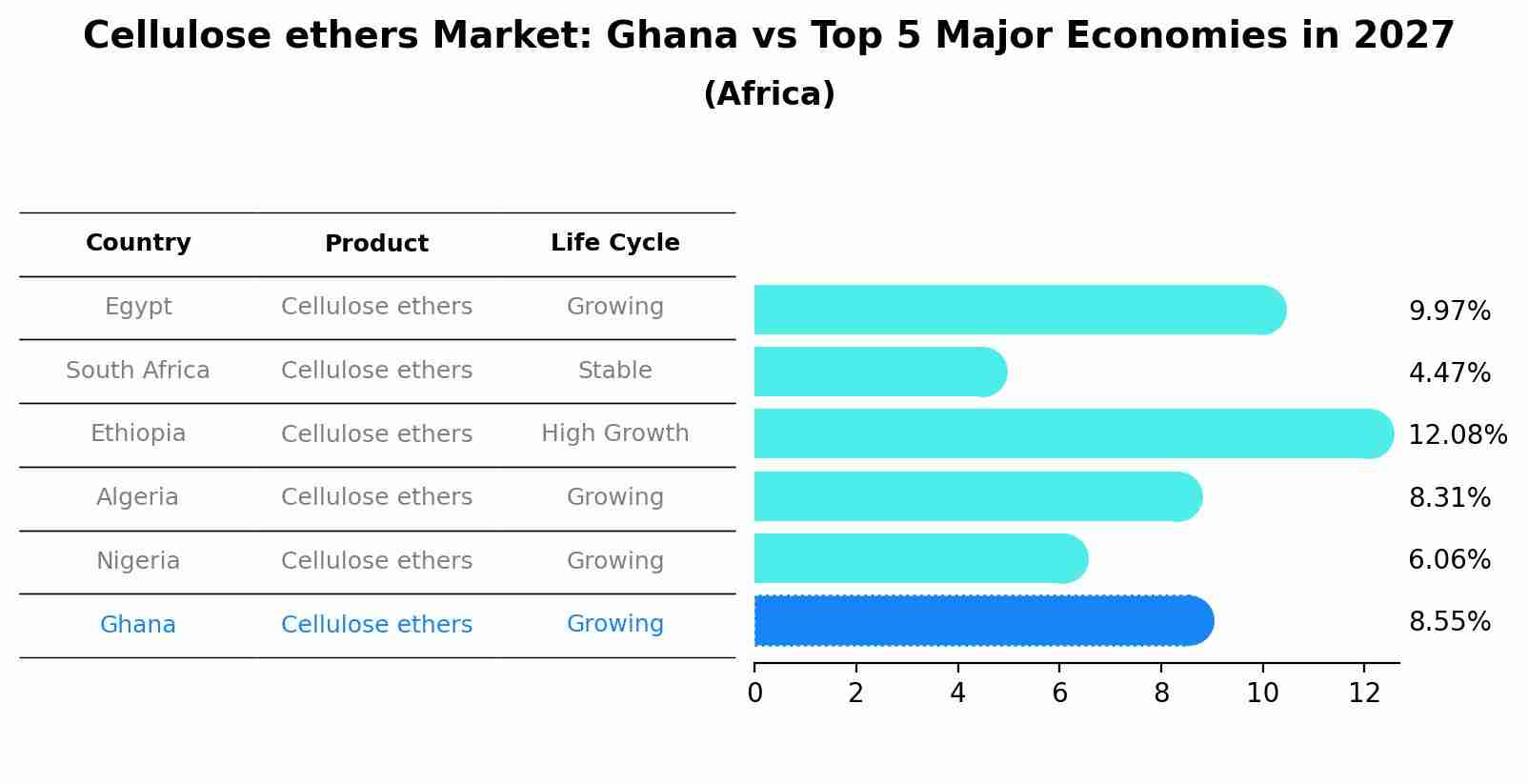Ghana Cellulose ethers Market (2025-2031) Outlook | Trends, Companies, Forecast, Growth, Analysis, Share, Size, Value, Revenue & Industry
| Product Code: ETC093075 | Publication Date: Jun 2021 | Updated Date: Apr 2025 | Product Type: Report | |
| Publisher: 6Wresearch | Author: Ravi Bhandari | No. of Pages: 70 | No. of Figures: 35 | No. of Tables: 5 |
Ghana Cellulose ethers Market Size Growth Rate
The Ghana Cellulose ethers Market is projected to witness mixed growth rate patterns during 2025 to 2029. From 8.29% in 2025, the growth rate steadily ascends to 13.37% in 2029.

Cellulose ethers Market: Ghana vs Top 5 Major Economies in 2027 (Africa)
The Cellulose ethers market in Ghana is projected to grow at a growing growth rate of 8.55% by 2027, highlighting the country's increasing focus on advanced technologies within the Africa region, where Egypt holds the dominant position, followed closely by South Africa, Ethiopia, Algeria and Nigeria, shaping overall regional demand.

Ghana Cellulose ethers Market Overview
In Ghana, the Cellulose Ethers Market is driven by factors such as construction industry demand, pharmaceutical formulations, and food and beverage applications. Cellulose ethers, including methyl cellulose, hydroxypropyl cellulose, and carboxymethyl cellulose, serve as water-soluble polymers for thickening, stabilizing, and binding agents in building materials, pharmaceutical formulations, and food products in Ghana, offering properties such as viscosity control, film formation, and texture enhancement.
Drivers of the market
The Ghana cellulose ethers market is driven by its applications as thickeners, stabilizers, and rheology modifiers in industries such as construction, pharmaceuticals, and personal care. Growing urbanization and infrastructure development are key drivers shaping this market.
Challenges of the market
Challenges in the cellulose ethers market in Ghana include limited awareness about the versatile applications of ethers in various industries, such as pharmaceuticals and construction. Moreover, quality control issues and regulatory compliance requirements impact market credibility and consumer trust.
Government Policy of the market
Government interventions in the cellulose ethers market may aim to promote sustainable materials, construction efficiency, and infrastructure development. Policies might include regulations and standards for cellulose ethers used in construction materials such as mortar, plaster, and adhesives to ensure their quality, performance, and compatibility with building codes and standards. Additionally, the government may support initiatives to develop technical guidelines, training programs, and certification schemes for construction professionals on cellulose ether applications, mixing techniques, and performance testing. Capacity-building programs for manufacturers, contractors, and engineers on sustainable construction practices, green building certification, and energy efficiency may also be promoted to enhance industry standards and environmental sustainability.
Key Highlights of the Report:
- Ghana Cellulose ethers Market Outlook
- Market Size of Ghana Cellulose ethers Market, 2024
- Forecast of Ghana Cellulose ethers Market, 2031
- Historical Data and Forecast of Ghana Cellulose ethers Revenues & Volume for the Period 2021-2031
- Ghana Cellulose ethers Market Trend Evolution
- Ghana Cellulose ethers Market Drivers and Challenges
- Ghana Cellulose ethers Price Trends
- Ghana Cellulose ethers Porter's Five Forces
- Ghana Cellulose ethers Industry Life Cycle
- Historical Data and Forecast of Ghana Cellulose ethers Market Revenues & Volume By Product Type for the Period 2021-2031
- Historical Data and Forecast of Ghana Cellulose ethers Market Revenues & Volume By Carboxymethyl Cellulose for the Period 2021-2031
- Historical Data and Forecast of Ghana Cellulose ethers Market Revenues & Volume By Methyl Cellulose & Derivatives for the Period 2021-2031
- Historical Data and Forecast of Ghana Cellulose ethers Market Revenues & Volume By Hydroxyethyl Cellulose for the Period 2021-2031
- Historical Data and Forecast of Ghana Cellulose ethers Market Revenues & Volume By Others for the Period 2021-2031
- Historical Data and Forecast of Ghana Cellulose ethers Market Revenues & Volume By Application for the Period 2021-2031
- Historical Data and Forecast of Ghana Cellulose ethers Market Revenues & Volume By Food and Beverage for the Period 2021-2031
- Historical Data and Forecast of Ghana Cellulose ethers Market Revenues & Volume By Pharmaceuticals and Healthcare for the Period 2021-2031
- Historical Data and Forecast of Ghana Cellulose ethers Market Revenues & Volume By Construction for the Period 2021-2031
- Historical Data and Forecast of Ghana Cellulose ethers Market Revenues & Volume By Cosmetics for the Period 2021-2031
- Historical Data and Forecast of Ghana Cellulose ethers Market Revenues & Volume By Personal Care for the Period 2021-2031
- Historical Data and Forecast of Ghana Cellulose ethers Market Revenues & Volume By Others for the Period 2021-2031
- Ghana Cellulose ethers Import Export Trade Statistics
- Market Opportunity Assessment By Product Type
- Market Opportunity Assessment By Application
- Ghana Cellulose ethers Top Companies Market Share
- Ghana Cellulose ethers Competitive Benchmarking By Technical and Operational Parameters
- Ghana Cellulose ethers Company Profiles
- Ghana Cellulose ethers Key Strategic Recommendations
Frequently Asked Questions About the Market Study (FAQs):
1 Executive Summary |
2 Introduction |
2.1 Key Highlights of the Report |
2.2 Report Description |
2.3 Market Scope & Segmentation |
2.4 Research Methodology |
2.5 Assumptions |
3 Ghana Cellulose ethers Market Overview |
3.1 Ghana Country Macro Economic Indicators |
3.2 Ghana Cellulose ethers Market Revenues & Volume, 2021 & 2031F |
3.3 Ghana Cellulose ethers Market - Industry Life Cycle |
3.4 Ghana Cellulose ethers Market - Porter's Five Forces |
3.5 Ghana Cellulose ethers Market Revenues & Volume Share, By Product Type, 2021 & 2031F |
3.6 Ghana Cellulose ethers Market Revenues & Volume Share, By Form, 2021 & 2031F |
4 Ghana Cellulose ethers Market Dynamics |
4.1 Impact Analysis |
4.2 Market Drivers |
4.3 Market Restraints |
5 Ghana Cellulose ethers Market Trends |
6 Ghana Cellulose ethers Market, By Types |
6.1 Ghana Cellulose ethers Market, By Product Type |
6.1.1 Overview and Analysis |
6.1.2 Ghana Cellulose ethers Market Revenues & Volume, By Product Type, 2021-2031F |
6.1.3 Ghana Cellulose ethers Market Revenues & Volume, By Carboxymethyl Cellulose, 2021-2031F |
6.1.4 Ghana Cellulose ethers Market Revenues & Volume, By Methyl Cellulose & Derivatives, 2021-2031F |
6.1.5 Ghana Cellulose ethers Market Revenues & Volume, By Hydroxyethyl Cellulose, 2021-2031F |
6.1.6 Ghana Cellulose ethers Market Revenues & Volume, By Others, 2021-2031F |
6.2 Ghana Cellulose ethers Market, By Application |
6.2.1 Overview and Analysis |
6.2.2 Ghana Cellulose ethers Market Revenues & Volume, By Food and Beverage, 2021-2031F |
6.2.3 Ghana Cellulose ethers Market Revenues & Volume, By Pharmaceuticals and Healthcare, 2021-2031F |
6.2.4 Ghana Cellulose ethers Market Revenues & Volume, By Construction, 2021-2031F |
6.2.5 Ghana Cellulose ethers Market Revenues & Volume, By Cosmetics, 2021-2031F |
6.2.6 Ghana Cellulose ethers Market Revenues & Volume, By Personal Care, 2021-2031F |
6.2.7 Ghana Cellulose ethers Market Revenues & Volume, By Others, 2021-2031F |
7 Ghana Cellulose ethers Market Import-Export Trade Statistics |
7.1 Ghana Cellulose ethers Market Export to Major Countries |
7.2 Ghana Cellulose ethers Market Imports from Major Countries |
8 Ghana Cellulose ethers Market Key Performance Indicators |
9 Ghana Cellulose ethers Market - Opportunity Assessment |
9.1 Ghana Cellulose ethers Market Opportunity Assessment, By Product Type, 2021 & 2031F |
9.2 Ghana Cellulose ethers Market Opportunity Assessment, By Application, 2021 & 2031F |
10 Ghana Cellulose ethers Market - Competitive Landscape |
10.1 Ghana Cellulose ethers Market Revenue Share, By Companies, 2024 |
10.2 Ghana Cellulose ethers Market Competitive Benchmarking, By Operating and Technical Parameters |
11 Company Profiles |
12 Recommendations |
13 Disclaimer |
- Single User License$ 1,995
- Department License$ 2,400
- Site License$ 3,120
- Global License$ 3,795
Search
Related Reports
- ASEAN Bearings Market (2025-2031) | Strategy, Consumer Insights, Analysis, Investment Trends, Opportunities, Growth, Size, Share, Industry, Revenue, Segments, Value, Segmentation, Supply, Forecast, Restraints, Outlook, Competition, Drivers, Trends, Demand, Pricing Analysis, Competitive, Strategic Insights, Companies, Challenges
- Europe Flooring Market (2025-2031) | Outlook, Share, Industry, Trends, Forecast, Companies, Revenue, Size, Analysis, Growth & Value
- Saudi Arabia Manlift Market (2025-2031) | Outlook, Size, Growth, Trends, Companies, Industry, Revenue, Value, Share, Forecast & Analysis
- Uganda Excavator, Crane, and Wheel Loaders Market (2025-2031) | Strategy, Consumer Insights, Analysis, Investment Trends, Opportunities, Growth, Size, Share, Industry, Revenue, Segments, Value, Segmentation, Supply, Forecast, Restraints, Outlook, Competition, Drivers, Trends, Demand, Pricing Analysis, Competitive, Strategic Insights, Companies, Challenges
- Rwanda Excavator, Crane, and Wheel Loaders Market (2025-2031) | Strategy, Consumer Insights, Analysis, Investment Trends, Opportunities, Growth, Size, Share, Industry, Revenue, Segments, Value, Segmentation, Supply, Forecast, Restraints, Outlook, Competition, Drivers, Trends, Demand, Pricing Analysis, Competitive, Strategic Insights, Companies, Challenges
- Kenya Excavator, Crane, and Wheel Loaders Market (2025-2031) | Strategy, Consumer Insights, Analysis, Investment Trends, Opportunities, Growth, Size, Share, Industry, Revenue, Segments, Value, Segmentation, Supply, Forecast, Restraints, Outlook, Competition, Drivers, Trends, Demand, Pricing Analysis, Competitive, Strategic Insights, Companies, Challenges
- Angola Excavator, Crane, and Wheel Loaders Market (2025-2031) | Strategy, Consumer Insights, Analysis, Investment Trends, Opportunities, Growth, Size, Share, Industry, Revenue, Segments, Value, Segmentation, Supply, Forecast, Restraints, Outlook, Competition, Drivers, Trends, Demand, Pricing Analysis, Competitive, Strategic Insights, Companies, Challenges
- Israel Intelligent Transport System Market (2025-2031) | Strategy, Consumer Insights, Analysis, Investment Trends, Opportunities, Growth, Size, Share, Industry, Revenue, Segments, Value, Segmentation, Supply, Forecast, Restraints, Outlook, Competition, Drivers, Trends, Demand, Pricing Analysis, Competitive, Strategic Insights, Companies, Challenges
- Uganda Precast and Aggregate Market (2025-2031) | Strategy, Consumer Insights, Analysis, Investment Trends, Opportunities, Growth, Size, Share, Industry, Revenue, Segments, Value, Segmentation, Supply, Forecast, Restraints, Outlook, Competition, Drivers, Trends, Demand, Pricing Analysis, Competitive, Strategic Insights, Companies, Challenges
- Australia IT Asset Disposal Market (2025-2031) | Strategy, Consumer Insights, Analysis, Investment Trends, Opportunities, Growth, Size, Share, Industry, Revenue, Segments, Value, Segmentation, Supply, Forecast, Restraints, Outlook, Competition, Drivers, Trends, Demand, Pricing Analysis, Competitive, Strategic Insights, Companies, Challenges
Industry Events and Analyst Meet
Our Clients
Whitepaper
- Middle East & Africa Commercial Security Market Click here to view more.
- Middle East & Africa Fire Safety Systems & Equipment Market Click here to view more.
- GCC Drone Market Click here to view more.
- Middle East Lighting Fixture Market Click here to view more.
- GCC Physical & Perimeter Security Market Click here to view more.
6WResearch In News
- Doha a strategic location for EV manufacturing hub: IPA Qatar
- Demand for luxury TVs surging in the GCC, says Samsung
- Empowering Growth: The Thriving Journey of Bangladesh’s Cable Industry
- Demand for luxury TVs surging in the GCC, says Samsung
- Video call with a traditional healer? Once unthinkable, it’s now common in South Africa
- Intelligent Buildings To Smooth GCC’s Path To Net Zero













